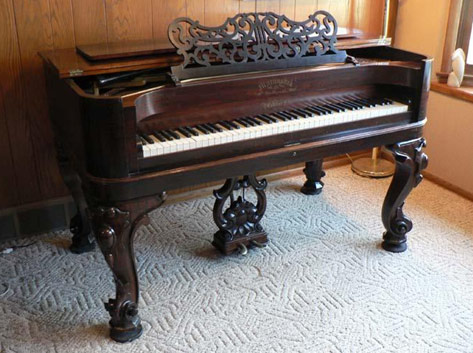Upright piano sales eclipsed the square grand around 1895, and by 1900 it was clear that the future of the square was to be very short. The trouble was that a great glut of square pianos were keeping prices down for new instruments. It was decided that something needed to be done to turn public desire away from square grands. On May 24, 1904 a well publicized event was staged by a conglomerate of piano dealers to eliminate the square grand, by staging a ceremonial bonfire of grand pianos.

Later reports would put the number of squares burned at over 1000, but the more likely number is less than 50, just owing to the logistics of assembling the things into a proper pile. In any case the era of the square grand was over in America, with the last ones made in 1905. Mathushek briefly resurrected the design in the 1930s to hearken back to old times, with an abbreviated size instrument, but owing to the depression and general indifference it met with, the experiment was short lived.

In America today, the large square grand enjoys the poorest possible reputation of any musical instrument extant. The actions were never capable of the performance of a traditional grand, though they were superior to many uprights. But mostly, they suffer from incompatibility of parts. Action parts for most upright and grand pianos can be replaced with modern equivalents when they break without much adjustment. Not so the square, where every part needs individual attention. If a wrest plank needs replacing, same story. The American piano technician sees squares as a ball of worms, to be avoided at all costs. It does not help that most squares have seen 100 years of neglect before a technician is called, and customer expectations are for the thing to be ‘tuned’ i.e., cost, oh, about $150 to make it right. Uh Huh…
They are somewhat of a difficult reach for tuning, though once set they tend to hold nicely if everything is in order. For a performance, they work best for period music. However, the serious piano student is so closely and carefully focused on one type of sound, one type of feel, and one technique, that there is no room for these monsters. Recordings on large American grands are extremely infrequent; they sound like normal pianos, feel different, and in the end, fail to express enough additional color to make it worthwhile attempting music on them for the studio. Professional restorers exist in the States to help you with your square grand, and mostly produce competent work, at prices that reach and exceed $10K! You will be assured that your piano will sell for at least twice this, and occasionally some actually do, but largely, restoration of a large American square grand is a matter of preserving a sentimental attachment to a family heirloom. |
